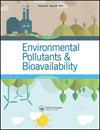印度洛克塔克湖(Loktak Lake)飞虱生物量蚯蚓堆肥过程中重金属生物利用度的降低
Q3 Chemical Engineering
引用次数: 6
摘要
蚯蚓堆肥是保护洛克塔克湖的一种很好的选择,对农业有很大的好处。以肥Eisenia fetida蚯蚓为试验材料,研究了45 d蚯蚓堆肥过程中飞虱生物量中营养物质(Na、K、Ca、Mg)和重金属(Zn、Cu、Mn、Fe、Ni、Pb、Cd、Cr)的生物利用度和淋溶性。以水溶性和可提取二乙烯三胺五乙酸(DTPA)的形式测定重金属的生物利用度。采用毒性特征浸出程序试验,测定了蚯蚓堆肥过程中可浸出重金属的含量。在此过程中,营养物质浓度增加;而水溶性、DTPA可萃取和可浸出重金属浓度在所有试验中均显著降低。肥Eisenia fetida对彭迪生物量的蚯蚓堆肥对降低某些重金属的生物利用度和浸出性非常有效。浸出性试验证实,制备的蚯蚓堆肥对土壤、植物和人体健康没有危害。在低投入的基础上,利用蚯蚓减轻蓬地生物量蚯蚓堆肥中的金属毒性和提高营养成分的可能性,有利于可持续的土地改造实践。本文章由计算机程序翻译,如有差异,请以英文原文为准。
Reduction of bioavailability of heavy metals during vermicomposting of phumdi biomass of Loktak Lake (India) using Eisenia fetida
Abstract Vermicomposting of phumdi biomass is a good alternative for protecting Loktak Lake and is advantageous for agriculture purposes. Research was carried out on bioavailability and leachability of nutrients (Na, K, Ca and Mg) and heavy metals (Zn, Cu, Mn, Fe, Ni, Pb, Cd and Cr) during vermicomposting of phumdi biomass for 45 days using Eisenia fetida earthworm. The bioavailability of heavy metals was determined in the form of water soluble and diethylene triamine penta-acetic acid (DTPA) extractable. The toxicity characteristic leaching procedure test was performed to determine the leachable heavy metals during the vermicomposting process. The concentration of nutrients increased during the process; whereas the concentration of water soluble, DTPA extractable and leachable heavy metals decreased significantly in all the trials. The vermicomposting of phumdi biomass by Eisenia fetida was very effective for the reduction of bioavailability and leachability of selected heavy metals. The leachability test confirmed that prepared vermicompost is not hazardous for soil, plants and human health. The possibility of using earthworms to mitigate the metal toxicity and to enhance the nutrient profile in phumdi biomass vermicompost, is advantageous in sustainable land renovation practices on a low-input basis.
求助全文
通过发布文献求助,成功后即可免费获取论文全文。
去求助
来源期刊
CiteScore
1.62
自引率
0.00%
发文量
0
审稿时长
1 months
期刊介绍:
Chemical Speciation & Bioavailability ( CS&B) is a scholarly, peer-reviewed forum for insights on the chemical aspects of occurrence, distribution, transport, transformation, transfer, fate, and effects of substances in the environment and biota, and their impacts on the uptake of the substances by living organisms. Substances of interests include both beneficial and toxic ones, especially nutrients, heavy metals, persistent organic pollutants, and emerging contaminants, such as engineered nanomaterials, as well as pharmaceuticals and personal-care products as pollutants. It is the aim of this Journal to develop an international community of experienced colleagues to promote the research, discussion, review, and spread of information on chemical speciation and bioavailability, which is a topic of interest to researchers in many disciplines, including environmental, chemical, biological, food, medical, toxicology, and health sciences.
Key themes in the scope of the Journal include, but are not limited to, the following “6Ms”:
Methods for speciation analysis and the evaluation of bioavailability, especially the development, validation, and application of novel methods and techniques.
Media that sustain the processes of release, distribution, transformation, and transfer of chemical speciation; of particular interest are emerging contaminants, such as engineered nanomaterials, pharmaceuticals, and personal-care products.
Mobility of substance species in environment and biota, either spatially or temporally.
Matters that influence the chemical speciation and bioavailability, mainly environmentally relevant conditions.
Mechanisms that govern the transport, transformation, transfer, and fate of chemical speciation in the environment, and the biouptake of substances.
Models for the simulation of chemical speciation and bioavailability, and for the prediction of toxicity.
Chemical Speciation & Bioavailability is a fully open access journal. This means all submitted articles will, if accepted, be available for anyone to read, anywhere, at any time. immediately on publication. There are no charges for submission to this journal.

 求助内容:
求助内容: 应助结果提醒方式:
应助结果提醒方式:


